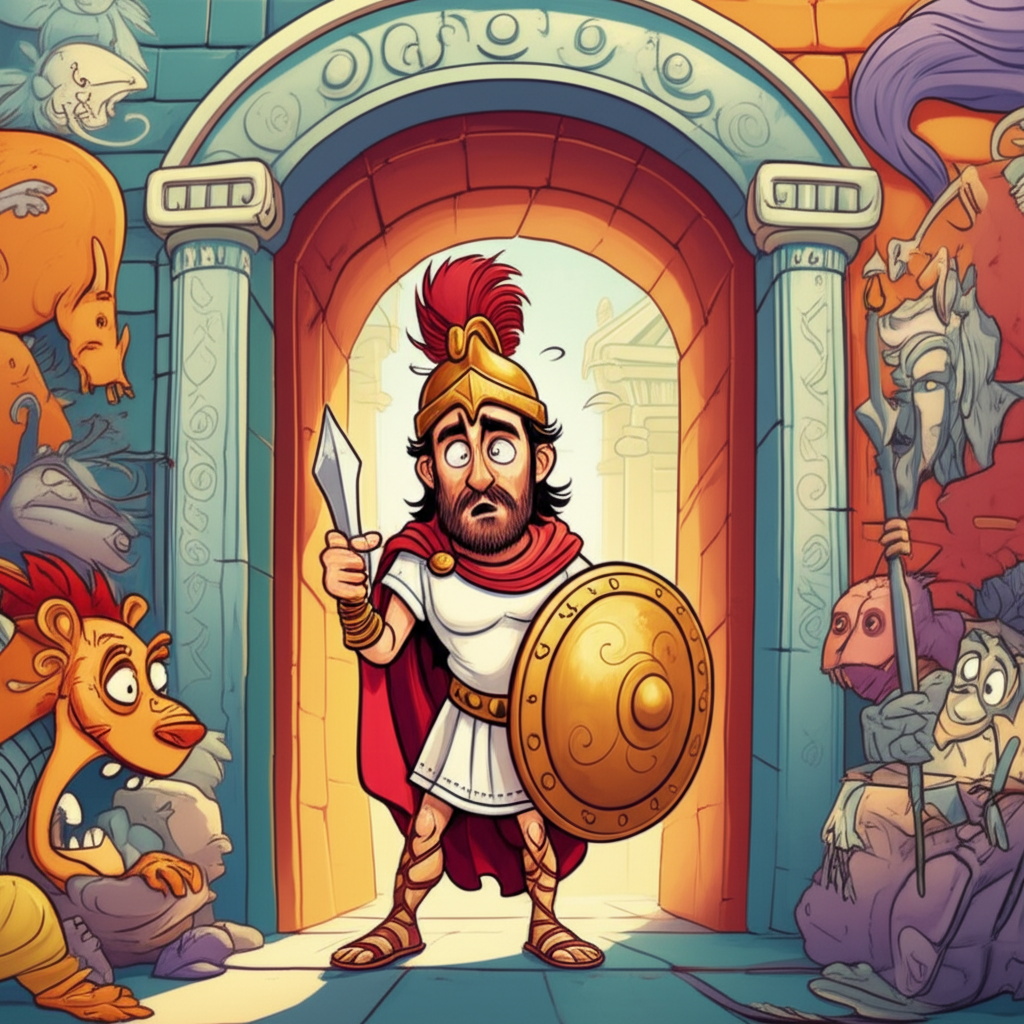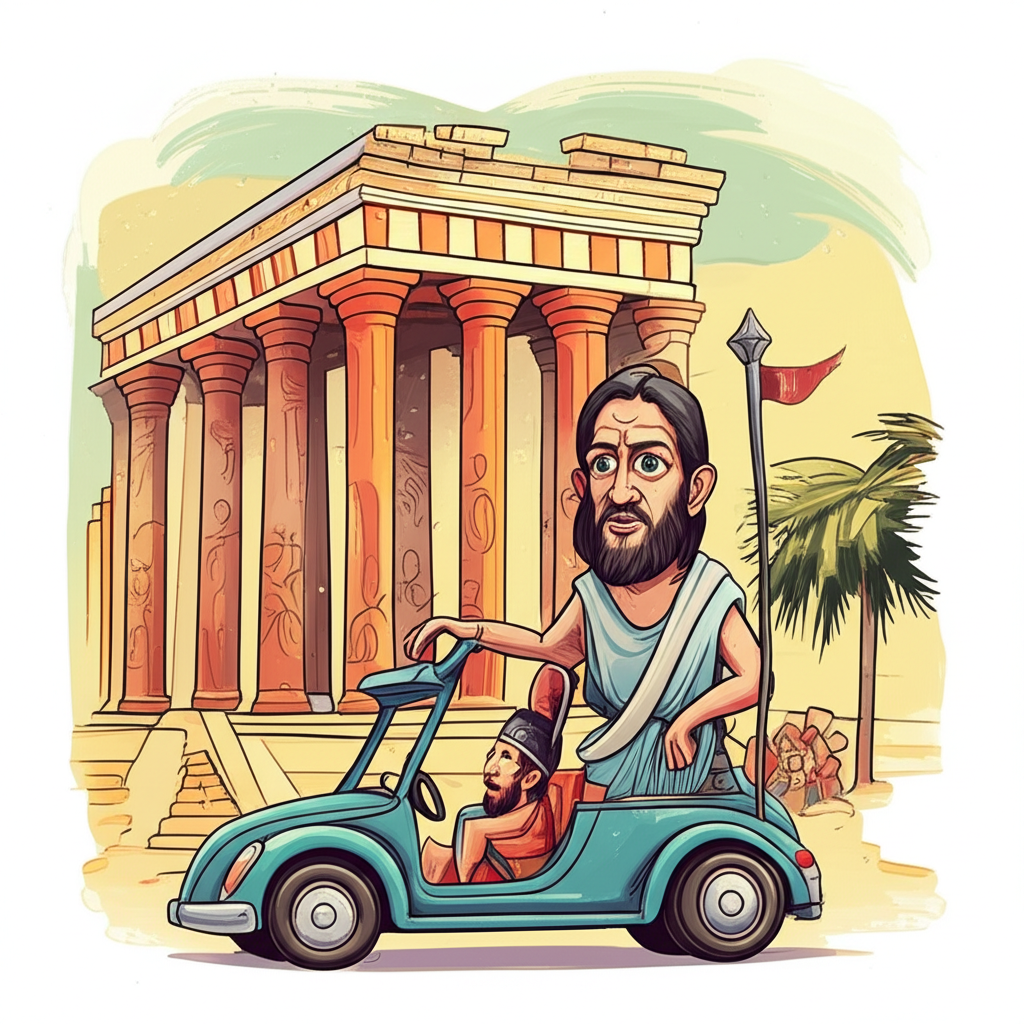
The Warrior and the Maze: A Retelling of Achilles in the Labyrinth
Introduction
From the sun-scorched islands and rugged mountains of ancient Greece comes a rich tapestry of myths and legends. These stories, populated by powerful gods, cunning heroes, and terrifying monsters, were the way ancient Hellenic peoples explored the great questions of their world: courage, fate, pride, and the struggle between order and chaos. Among the most famous figures are the peerless warrior Achilles and the monstrous Minotaur, confined within its impossible Labyrinth. While tradition tells us it was the Athenian prince Theseus who braved the maze, the power of myth lies in its ability to be reshaped. This article explores a speculative legend, a "what if" of the ancient world: what if the greatest warrior of all, Achilles, had been the one to face the Labyrinth of Crete? This is a traditional story, told not as a matter of faith, but for cultural, historical, and educational understanding of the values and imagination of an ancient civilization.
Origins and Cultural Background
This tale is rooted in the Greek Bronze Age, an era immortalized in epic poems like the Iliad and the Odyssey. The society of this time was a collection of fiercely independent city-states, often in competition with one another. For the people of this era, the world was a place directly influenced by the gods of Mount Olympus—powerful, immortal beings with very human-like emotions and ambitions. Fate was a tangible force, and prophecies from oracles could shape the destinies of kings and kingdoms. In this world, heroes were exceptional mortals, often demigods, who stood as intermediaries between the human and divine. Their quests were not just adventures; they were reflections of cultural ideals. A hero’s kleos (glory) and timē (honor) were paramount, and achieving an immortal reputation through great deeds was the highest possible calling. Stories like these were shared orally by bards in great halls, reinforcing cultural values and explaining the unexplainable.
Character and Creature Description
-
Achilles: The central figure of this imagined tale is Achilles, prince of the Myrmidons. The son of the mortal king Peleus and the sea-nymph Thetis, he was the embodiment of martial perfection. Dipped in the magical River Styx as an infant, his body was said to be invulnerable, save for the heel by which his mother held him. He was blessed with breathtaking speed and a strength that no other mortal could match. Symbolically, Achilles represents more than just physical power; he is the avatar of supreme, focused rage and unyielding pride. His story is often a tragedy, exploring the idea that even the greatest strength cannot overcome fate or a fatal flaw.
-
The Minotaur: At the heart of the Labyrinth dwelt the Minotaur, a creature of profound horror. It was a being with the body of a powerful man and the head of a bull, born from a curse laid upon King Minos of Crete. Imprisoned by its own father in the center of an inescapable maze, the Minotaur was a symbol of primal savagery and the terrifying consequences of defying the gods. It represented the bestial nature that civilization sought to contain—a monstrous secret hidden beneath the floors of a grand palace.
-
The Labyrinth: Designed by the master inventor Daedalus, the Labyrinth was not merely a maze but a marvel of architecture and psychological warfare. It was a sprawling, shifting network of corridors, dead ends, and false passages, built to confuse and demoralize any who entered. Symbolically, the Labyrinth represents the ultimate challenge—a problem that cannot be solved by strength alone. It is a metaphor for chaos, the unknown, and the winding, confusing journey into the darkest parts of the self.
Main Story: The Narrative Retelling
The story begins not with a tribute of youths and maidens from Athens, but with a challenge born of arrogance. King Minos of Crete, lord of the seas, had grown weary of the whispers that the Athenian Theseus had defeated his beast through trickery—a simple ball of thread from the king’s own daughter. To reassert his power and the terror of his Labyrinth, Minos issued a decree to all the city-states of Greece: send your greatest champion to face the Minotaur. None dared, for the Labyrinth was a puzzle of the mind, and the Minotaur a beast of pure rage.
The challenge reached the shores of Phthia, where the young prince Achilles trained, his spear a blur, his feet faster than the wind. For him, life was a series of contests to be won, his name a legacy to be forged in glory. While others heard Minos’s challenge and felt fear, Achilles heard only an opportunity. His mother, Thetis, pleaded with him, her divine sight showing her a thousand dark fates in the maze’s shadow. But Achilles’s pride was a fire that could not be quenched. He would not solve the Labyrinth; he would conquer it.
Upon his arrival in Crete, Achilles presented a stark contrast to the heroes who came before. He was not a prince seeking diplomacy or an adventurer seeking aid. He was a weapon given human form. When offered the help of Princess Ariadne, he scoffed. "A warrior needs no thread to guide him," he declared, his hand resting on the hilt of his sword. "My path is forward. The beast’s end is my guide."
He entered the Labyrinth not with caution, but with a battle cry that echoed through the stone corridors. The maze was designed to disorient, its twisting paths meant to inspire despair. For any other man, it would have been a slow descent into madness. But Achilles was not any other man. He did not try to map the corridors or remember his turns. He treated the Labyrinth as an opponent. When a dead end blocked his path, he did not turn back; he lowered his shoulder and smashed through the wall, the ancient stone crumbling before his divine strength. When passages twisted in on themselves, he used his incredible speed to race through them, trusting his warrior’s instinct to sense the direction of his prey.
He followed not a map, but the faint, foul scent of the beast and the distant sound of hooves scraping on stone. The Labyrinth fought back, its disorienting geometry pressing in on him, but Achilles’s singular focus was a force of nature. He was not solving a puzzle; he was hunting.
At last, he burst into the central chamber. There, in the gloom, stood the Minotaur. It was a creature of immense power, its bellow of rage shaking the very foundations of the maze. The beast charged, horns lowered, expecting to gore a terrified victim. Instead, it met the whirlwind. Achilles did not stand his ground; he moved like a phantom. He sidestepped the initial rush, his spear a flash of bronze, scoring a deep gash along the creature’s flank. The Minotaur roared in pain and fury, turning to charge again. But Achilles was already gone, circling, his speed a weapon the monster could not comprehend.
The fight was not a prolonged struggle but a swift, brutal execution. The Minotaur was all brute force; Achilles was force guided by lethal skill. He darted in and out, his spear finding its mark again and again, until the great beast finally staggered and fell, its lifeblood pooling on the cold stone floor.
But the challenge was only half complete. Now he had to escape. Lost in the heart of an impossible maze, with no thread to guide him, Achilles chose the only path he knew: the direct one. With a roar of triumph and fury, he turned not to the winding corridors but to the nearest wall. He began to run, a human battering ram, smashing his way through stone and mortar. He did not navigate his way out of the Labyrinth; he carved his own exit, leaving a trail of destruction in his wake. He emerged into the Cretan sunlight not as a clever hero, but as an unstoppable storm, covered in dust and gore, having shattered the puzzle he refused to solve.
Symbolism and Meaning
To the ancient Greeks who might have imagined such a story, this version would carry a different meaning than the traditional myth of Theseus. Theseus’s victory, aided by Ariadne’s thread, represented the triumph of intellect, strategy, and civilization over brute force. It was a story about how human ingenuity and cooperation could overcome even the most monstrous challenges.
Achilles’s victory, by contrast, would symbolize the overwhelming power of a singular, divinely-gifted individual. It is a story about the application of absolute force. He does not outwit the Labyrinth; he demolishes it. This speaks to the Greek admiration for martial prowess but also serves as a cautionary tale. Achilles solves the problem, but his solution is destructive and devoid of cunning. The story would ask a profound question: Is it better to be the man who can solve any puzzle, or the man who is strong enough to shatter it?
Modern Perspective
Today, the elements of this story continue to resonate deeply in modern culture. Achilles remains the archetypal warrior, his name synonymous with both unparalleled skill and a single, fatal weakness ("Achilles’ heel"). He appears in films like Troy and is re-examined in novels like Madeline Miller’s The Song of Achilles, which explores his humanity behind the legend. The Labyrinth is a powerful, enduring metaphor for complex problems, psychological journeys, and intricate systems, appearing in movies like Inception and Pan’s Labyrinth, and as a common trope in video games. The Minotaur, too, endures as a classic monster, representing the untamed beast within or the terrifying "other" in countless fantasy settings.
Conclusion
The tale of Achilles in the Labyrinth, though a creative blend of established myths, serves as a powerful testament to the flexibility and depth of ancient storytelling. It is a cultural artifact, a product of a vibrant oral tradition designed to explore the ideals and anxieties of its people. These narratives were never meant as literal truths but as imaginative frameworks for understanding the human condition.
As Muslims, we recognize that only Allah is the true Creator and Sustainer of the universe, and these mythological figures hold no power or divinity.
By studying these stories, we gain a valuable window into the past, appreciating the rich cultural heritage and profound imagination of ancient civilizations. They remind us of the timeless power of storytelling to capture our fears, celebrate our strengths, and question the very nature of what it means to be a hero.





